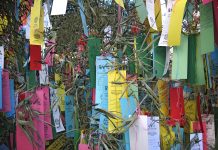Traditionally in Scandinavian countries on the 21st of June, bonfires glow in a night with no darkness, since at this time of year the sun never really sets. On this evening, buried treasures can be discovered by studying how moonbeams fall. Girls and young women pick flowers on their way home and lay them under their pillows so that that their dreams reveal who their husbands will be. They also keep watch at springs for a reflection of their husband-to-be in the water. Long considered a magical night, it is a popular time of year for weddings and christening ceremonies and is the best time for telling people’s futures.
What are these mysterious practices? These are all examples of the ancient customs that were carried out on Midsummer’s Eve in the hours leading up to the joyful celebration known as Midsummer Festival.
Summer in Scandinavian countries is short but very special. Mother Nature bursts into bloom in June with an amazing display of lush green, a rainbow palette of flowers and nights that barely darken. The Midsummer festival is a celebration of the Summer Solstice—the longest day of the year (June 21). Most Midsummer’s Eve celebrations take place on the Saturday between June 20 and June 26 and on the preceding evening. It is one of Scandinavia’s most popular festivals and observed as a national holiday in Sweden.
The celebration of the summer solstice is an ancient practice dating back to pagan times. The Midsummer tradition, which originally honored the defeat of darkness by the powers of the sun god, was traditionally a fertility festival, with customs and rituals centered around the bounties of nature and the hope for a good harvest the coming autumn.
One of the key elements of the festival is the maypole (Majstång). People often begin the day by picking flowers and making wreaths to place on the maypole, which is later raised in an open area. It is then time for the traditional ring-dances, folk songs and games to ensue, to the delight of children and grown-ups alike. Another is the lighting of bonfires, a practice that, in Europe, dates back to the 6th century A.D.
In Sweden, where the festival is known as Midsommar, it is celebrated in the countryside in large gatherings and is an occasion that brings whole families together. People decorate their houses inside and out with wreaths and flower garlands and bonfires are lit for this day of dancing, singing and general merrymaking. Almost every part of Sweden can boast its own folk costume; however, these colorful ensembles are rarely worn except at Midsummer.
Midsummer’s Eve is also a popular celebration in Norway, where it is also called Jonsok. In Denmark the holiday coincides with Sankt Hans aften (St. John’s Eve), which Danes celebrate on the eve of June 23rd. In both these countries, the holiday is celebrated with large bonfires and processions in the evening.
As with all major Scandinavian traditions, celebrating entails good holiday food. A traditional Midsummer menu features different kinds of herring, smoked fish, boiled new potatoes (served with fresh dill, sour cream and raw red onion in Sweden, for example), fresh fruit, such as the first strawberries of summer, as well as cold beer and schnapps, preferably spiced! When the glasses are refilled, the singing begins once again.


































